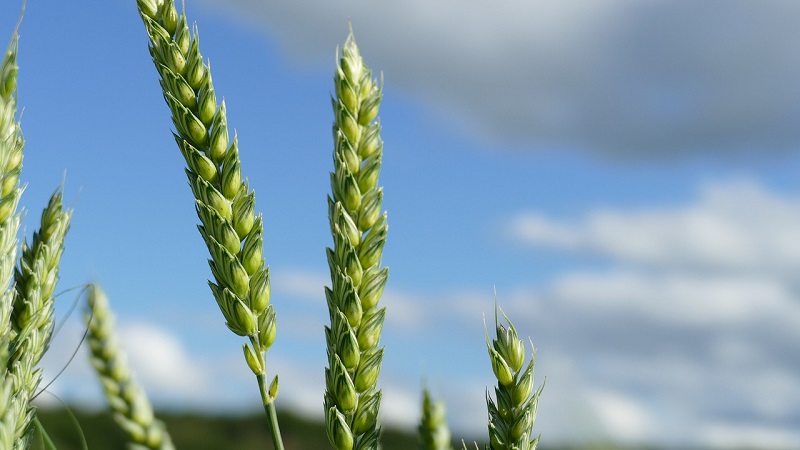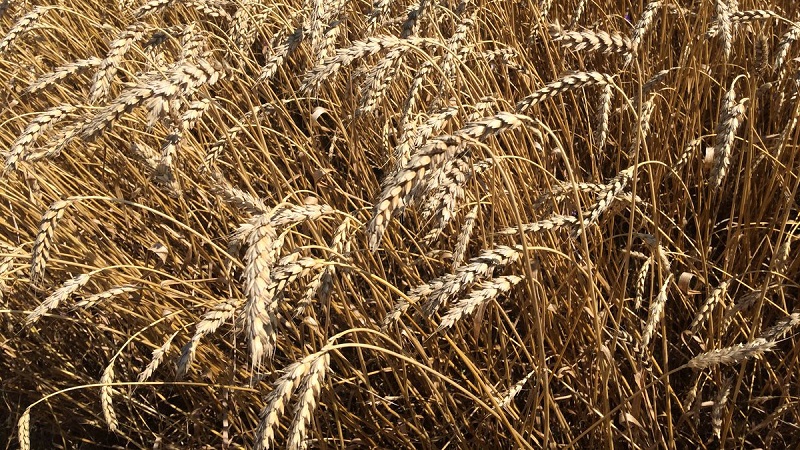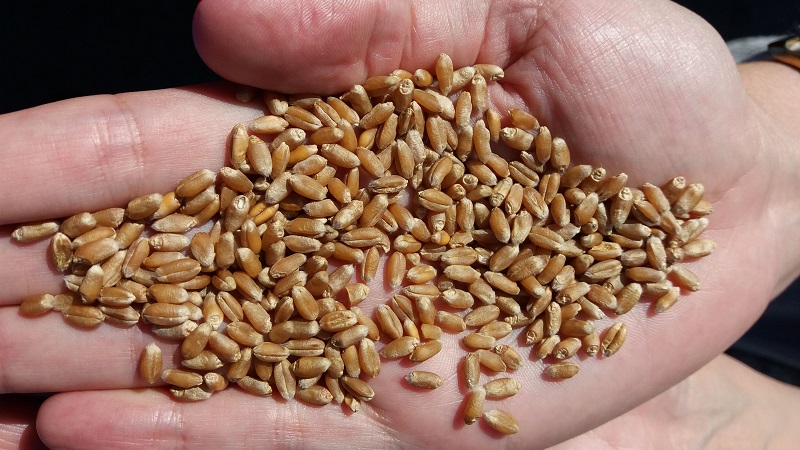Review of winter wheat varieties Alekseevich: characteristics and description
In 2015, the Krasnodar Research Institute of Agriculture bred a new variety of winter wheat, which broke all yield records. The variety named Alekseevich has successfully passed state tests. For more information about the features of this culture, read our article.
The content of the article
Description and characteristics of winter wheat Alekseevich
Alexeyevich - mid-season winter wheat variety with high yields.
Plant height reaches 81 cm, the variety belongs to semi-dwarf... Resistant to lodging. Mid-season, ripens about a day earlier than standard varieties. The shape of the bush is intermediate, the leaf is not omitted, the color is green. The ear is white, medium density, pyramidal in shape. The grain is of medium size and has an ovoid shape. The base of the grain is bare, red.
The main feature of the variety is its highest yield., as well as in the ability to maintain high taste, even when grown in conditions of deficiency of minerals.

In addition to all of the above wheat Alekseevich has the following properties:
- frost resistance;
- high baking quality;
- resistance to most common diseases and pests.
The variety is intended for cultivation in regions with a warm climate.... Approved for cultivation in the Central Black Earth and North Caucasian regions of the Russian Federation.
Interesting on the site:
Review of the best varieties of winter wheat
Growing features
The recommendations for growing technology are similar to those for growing other varieties of winter wheat.
Sowing technology
The best predecessors for Alekseevich - perennial plants, peas, rapeseed, corn, early ripe potatoes, it is also permissible to sow wheat after oats. Seeding rate: 5 million seeds per hectare.
The soil must have optimal density and structure, be well leveled - this will ensure a uniform seed placement depth. A field prepared for sowing should have a dense sub-sowing layer with a predominance of soil particles with a diameter of 1-3 mm. Sowing depth - 3-5 cm. Sowing method - usual row sowing with row spacing up to 15 cm, with tramline.
Important! Rolling the field after planting the seeds is mandatory.
The optimal sowing time is September 10-20... By wintering, the plants should reach 55-60 days of age and form 2-4 developed shoots.
Care
A set of measures for the care of wheat is aimed at safety of crops and, as a result, high yield.

Wheat care begins before sowing... To do this, carefully examine the level of soil moisture, the presence of pests and weeds.
The culture needs feeding... The fertilizer rate is calculated taking into account the composition of the soil and the predecessor. As a rule, the average rate of organic fertilizers is 20-30 tons per hectare. Sufficient supply of wheat with nutrients has a positive effect on yield, frost resistance, and lodging.
The crust that forms in the field after precipitation falls is disturbed by harrowing before germination... To do this, use rotary hoes or light furrows, while destroying weeds that are in the initial stage of development.
In winter, monoliths are selected and grown on cropsbased on the state of which conclusions are drawn about the state of plants, they plan measures to prevent diseases and crop death.
In the spring the crops are harrowed... This makes it possible to remove dead plant parts and destroy weeds. Dense crops must be harrowed in two tracks.
Alexeyevich highly resistant to most common diseases and pests wheat crops. The variety is most susceptible to Septoria and Fusarium spike.
Read also:
Yield
Breeders managed to achieve record yields - Alekseevich is twice ahead of his predecessors... Productivity potential - 120 centners per hectare. For other varieties, this figure is 40-50 centners per hectare.
Reference. In greenhouse conditions, you can get a yield of 132 centners per hectare.
Collection technology and timing
Harvesting is carried out when the crop reaches wax ripeness - during this period, spikelets and grains acquire a yellow tint. At least 75% of the crops must reach this degree of maturity.
The optimal harvest time for the variety is July 15-30... The harvesting campaign is carried out in a short time - no more than 8 days.

For harvesting, methods of direct and separate combining are used.... Harvesting is carried out before the ears are completely dry and start to crack.
After threshing grain is delivered to the elevator, where it is further processedwhich includes:
- filtration from weeds and insects;
- calibration;
- drying;
- cooling.
Storage
Store wheat in a well-ventilated, ventilated area with a humidity of 65-70% and temperature no more than + 8 °. Before laying the grain, the premises are disinfected. The grain in the storage is periodically stirred to avoid self-heating and spontaneous combustion.
Advantages and disadvantages of the variety
Winter wheat Alekseevich has a number of advantages:
- high yield rates;
- resistance to common diseases and pests;
- high baking quality.
The disadvantages of the variety include the following:
- suitable for cultivation only in the southern regions;
- high price.

Price
The cost of 1 ton of wheat varieties Alekseevich is from 30 to 35 thousand rubles.
Conclusion
Alekseevich winter wheat is one of the most productive varieties, suitable for growing in the southern regions. It belongs to mid-season and shows a record yield, significantly exceeding the indicators of similar varieties. Other advantages of Alekseevich include unpretentiousness, resistance to diseases and pests, good baking and taste qualities of grain.